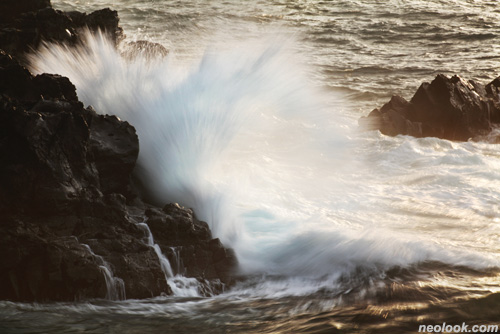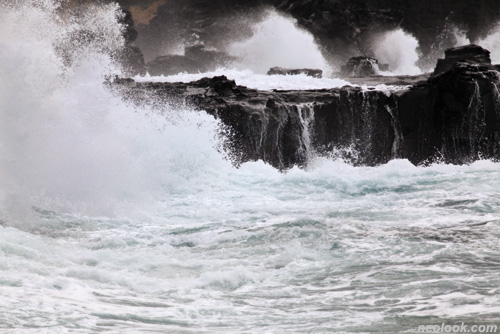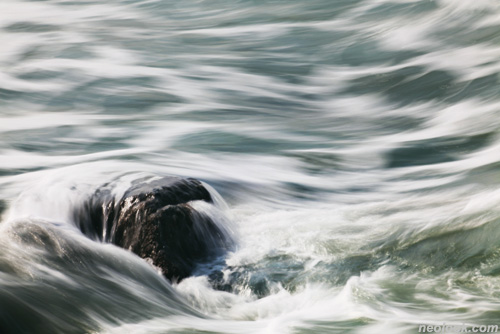- ● homepage
- ● archives
- ● restoration
- ● books
- ● big banners
- ● post board
- ■ neo's search
- ■ about us
- ■ 게재방법 안내
- 개인정보처리방침

- [email protected]
- Tel. 02_335_7922
- Fax. 02_335_7929
- 10:00am~04:30pm
- 월요일~금요일
- 3/3(월) 대체공휴일

바다의 합창 Chorus of the Sea
오동신展 / OHDONGSHIN / 吳東新 / photography 2013_0417 ▶ 2013_0430

- 오동신_비바체 ii Vivace ii_피그먼트 프린트_86×119cm_2012
초대일시 / 2013_0417_수요일_05:00pm
관람시간 / 10:00am~07:00pm
토포하우스 TOPOHAUS 서울 종로구 인사동11길 6(관훈동 184번지) Tel. +82.2.734.7555/+82.2.722.9883 www.topohaus.com
바람과 물, 결을 읽는 시간 ● 단어 하나로 떠올릴 수 있는 이미지는 사람마다 다를 것이다. '바다'라고 부를 때의 울림, 바다의 색깔, 소리, 냄새 등과 함께 연상되는 이미지라면 더욱 그럴 것이다. 우선 바다를 소재로 한 많은 영화 가운데서 내게는 프랑소아 오종 Francois Ozon 감독의 영화『Time to Leave』(2005) 의 첫 장면과 마지막 장면이 먼저 떠오른다. 영화는 바다를 바라보고 있는 한 어린아이의 뒷모습을 비추는 것으로 시작한다. 주인공의 어릴 때 모습이다. 순환구조처럼 영화의 마지막 장면에도 등장하는 바다, 병에 걸린 서른한 살의 주인공은 다시 그곳으로 돌아왔다. 그에게 바다는 생명을 잉태했던 '물'이었다가, 마지막에는 다시 돌아오게 되는 영혼의 안식처와 같을 것이다. ● 이유는 여러 가지겠지만, 많은 사람들은 바다로 산으로, 잠시 여행을 가거나 혹은 삶의 자리를 옮기기 위해 떠나간다. 그곳에 무엇이 있어서, 무엇을 보고자 자연 속으로 가는 것인가. 힐링과 웰빙이 이 시대의 화두가 되면서 치유를 위하여 혹은 삶의 새로운 계기를 만들기 위하여 자연 속으로 떠나는 것이 유행처럼 되었다. 그 장소 중에서 바다는 이미 많은 예술가가 시와 음악으로, 그림으로 표현하였고, 사진으로 담아두고자 했던 동경의 대상이자 불멸의 소재였다. 시인들은 자연의 원리를 관찰하고 그것을 삶의 이치에 대입하면서 인간을 이해하고자 하였다. 영국의 시인 캐슬린 레인은 이런 말을 하였다. "우리가 자연과 하나가 될 때, 우리는 이를 통해 무한한 자신의 세계를 발견하게 된다." 결국은 그곳에 있는 무엇을 보는 것이 아니라, 내 안의 나를 마주하게 된다는 것이다. 망망한 바다를 향해 있는 시선은 결국 자신을 향한 것이며, 바다는 자신의 내면과 마주할 수 있는 거울일 것이다. 그렇다면 사진가가 자연을 대상으로 삼는 것과 자연과 하나가 된다는 것은 어떻게 다른 것인가? ● 늦게 사진 작업을 시작하신 분이 제주의 바다를 찍었다고 했다. 그러기 위해서 서울생활을 정리하고 내려가 2여 년간 제주도에서 살았다고 했다. 먹고 사는 것에 구애받지 않고 그런 시간을 가질 수 있다는 것은 부러운 일이다. 그래서 카메라를 들지 않는 날의 일상이 어떠했을까 궁금했다. 실은 그가 어떤 바람과 파도를 느끼며 제주 바다를 마주하고 왔는지, 그럼으로써 자신 안의 또 다른 어떤 세계를 발견하였는지가 먼저 궁금했던 것이다. 파도가 치게 되는 주된 원인은 바람이라고 한다. 바다 표면과 바람의 마찰로 인하여 생기는 에너지의 양에 따라, 바람이 물살을 밀어내는 세기에 따라 다양한 크기의 파도가 만들어진다는 것이다. 그는 오랫동안 바람 많은 제주 날씨와 바다의 상태를 관찰했을 것이다. 그러다 하나의 풍경으로 관조하는 것이 아니라, 바다라는 실체 가까이 성큼 들어가 버린 듯하다. 그러면서 인간의 눈으로는 관찰하기 쉽지 않은 바람의 느낌과 세기, 빛의 강도, 시간과 같은 요소를 카메라의 속성을 빌어 가시화시키고자 했다. 빠른 셔터 속도, 때로는 장노출로 인하여 허공에서 물방울로 멈춰있거나 때로는 현무암 바위 사이로 휘돌아나가는 다양한 형태의 파도가 연출되었다. 실제 모습보다 더 강렬하고 격정적인 장면을 만들고자 했던 그의 욕망을 읽을 수 있다. 이 장면에서마다 그는 바다의 합창을 들었다고 했다. 눈으로 보더라도 충분히 소리의 파장을 감지할 수 있지만, 그는 좀 더 선명하게 속도로 규정함으로써 이미지를 청각화한 듯하다. 음악에서 빠르기를 뜻하는 용어를 각 사진에 이름으로 붙여준 것이다. 이로써 사진 속에 흐르던 에너지는 이제 자기만의 리듬을 가지게 되었다. 라르고(largo 아주 느리게)에서 시작하여 안단테(Andante 느리게)로, 모데라토(Moderato 보통 빠르기로)에서 점점 더 알레그로(Allegro 빠르게), 비바체(Vivace 아주 빠르게), 프레스토(Presto 매우 빠르게)로 이어진다.

- 오동신_모데라토 iv Moderato iv_피그먼트 프린트_64×88cm_2011
그동안 다양한 바다 사진을 보아왔고 여러 바다를 보러 다녔다. 소란스러운 도시생활이 어느 순간 견디기 어려울 때, 사람들과의 관계가 마치 손가락 사이로 새어나가는 모래알처럼, 썰물처럼 빠져나간다고 느껴질 때 나는 바다에 갔었다. 끝을 가늠할 수 없는 수평선, 바다 표면에서 반사되는 빛을 받으며, 바람으로 바다 내음을 받아들이며, 마음이 다시 헐거워지기를 기다렸다. 누군가는 음악으로 위안을 삼고, 친구에게서 위로를 얻을 것이다. 나에게는 말이 없는 바다가 오히려 최선일 때가 있다. 그것은 시각적인 이미지가 아니라 그 장소의 공기와 기운을 공감각적으로 느끼게 해주는 실제여야 했다. ● 오늘, 다시, 문득 영화 『Time to Leave』 두 장면에 최영미의 「속초에서」의 시구가 겹쳐진다. '바다, 일렁거림이 파도라고 배운 일곱 살이 있었다. ... (중략) .... 바다, 밀면서 밀리는 게 파도라고 배운 서른두 살이 있었다.' ● 이 우연한 연상은 묘하게도 시에서 언급하는 두 나이가 영화 초반에 등장한 주인공의 어릴 때와 다시 바다로 돌아왔을 때의 나이와 거의 일치하기 때문이다. 바다는 늘 그 자리에 있었지만, 돌아와 마주 선 그는 더 이상 과거의 그가 아니었다. 단순한 '일렁거림'의 상태였던 파도에서 '밀면서 밀리는' 것이 파도라고 알게 되는 것은 연륜에 의해서만 체득될 것이기 때문이다. '밀면서 밀리는' 파도의 양가적인 면을 볼 수 있다는 건 자연의 원리를 통해 삶의 이치를 깨달은 것이라고 해석할 수 있다. ● 오동신의 사진적인 행보는 이후 어디로 이어질지 지금으로서는 알 수가 없다. 그가 찍은 사진이 이제 막 새로운 것을 시작한 청년다운 에너지를 담고 있는 것은 사실 의외였다. 한 책에서 성인기의 삶을 연령대로 나누면서 60대를 '인생을 재설계하는 시기'라고 한 것이 기억난다. 일흔을 앞둔 그가 지난 2여 년간 바다를 마주하면서, 인생의 남아있는 시간은 사진을 찍으면서 보내기로 정했다고 했다. 그는 육십에 진정 자신의 '바다'를 발견한 것일까? ● 그가 바다가 아닌 다른 대상을 택한다고 하더라도 문제 될 것은 없어 보인다. 이제 막 시작한 사람으로서 숨이 가빴던 첫 호흡을 스스로 조절할 수 있다면, 어떤 바람과 물결 속에서도 자기만의 속도를 유지할 수 있다면… ■ 김소희

- 오동신_라르고 ii Largo ii_피그먼트 프린트_64×88cm_2011
Time to read the wind, water and texture ● The image a word evokes different images from person to person, especially powerful images complete with color, sound and the smell of the sea. The first and last scene of Time to Leave (2005), directed by Francois Ozon, is one such transformative scene that comes to mind first among various movies object the sea. The film begins by illuminating a young child's back overlooking the sea. It is protagonist's childhood looks. The ailing thirty-one-year-old protagonist came back to the sea in last scene of the movie like a circular structure. For him, the sea is not only 'water' carrying a new life, but the soul's haven at last. ● Variety reasons move a lot of people to visit the sea and mountain for a holiday or changing habitat. Why do they go to nature to find something to do or see? Healing and wellness has become a topic of this generation, thereby leaving to nature become a trend to create new opportunities in one's life. Numerous artists have sought to express the spirit of the sea by poem, music, drawing and photograph. Poets seek to understand human nature through observing the principles of nature and substituting the logic of life. British poet Kathleen Lane said that "When we become one with nature, we discover our own infinite world." As a result, I face my inner self, instead of something material. Gaze to boundless ocean toward the self after all. Moreover the sea would be a mirror to face something inside the self. If so, what is different from targeting nature and being one with nature to the photographer? ● I heard of the person who started photography in his later years, taking a photograph of the sea around Jeju Island. He left Seoul life behind to photograph Jeju Island for 2 years. It is enviable to have such time without worrying to earn his keep. So, I was curious about his life before he carried a camera. In fact, I wonder not only how he faced the sea with wind and waves, but how he found his own world. ● The wind is the main cause of waves. The various size of waves depend on the amount of energy that occurs due to the friction of the sea surface and the wind. He would observe the weather of Jeju and the state of the sea for a long time. Besides observing as one landscape, he seemed to jump into the truth of the sea. He sought to visualise the elements that are difficult to observe by human eye, such as the feel of the wind, intensity of the light, and time, through the properties of the camera. Due to fast and slow shutter speed, the image shows various figures of the wave, such as droplet hanging in the air, or water swinging out through the basalt rock. I could read his desire to make more intensive and passionate scenes than those actually appearing before him. From these scenes, he heard the chorus of the sea every time. He auralise the image by defining as speed, though it is enough to sense the wavelength of the sound by eyes. He gave the name of each images with a tempo signature. Thus the energy flowing in the image could have its own rhythm. ● It is Largo(very slowly), Andante(Slowly), Moderato(Moderately), Allegro(Fast and quick), Vivace(Lively and fast), and Presto(Very fast). ● I have been seen various photography of the sea and have been to see a various figure of the sea. At some points, I feel the city life is unbearable, and relationships are like a sand leaking through my fingers. At these times, I went to sea. There is the horizon that can not be measured the end, the reflected light from surface of the sea, and the salty smell of the sea. And I waited for a time for my mind to be loosened. Some get comfort from music and friends. Sometimes the silent sea is best for me. It should be an virtuality to feel the air and energy of that space, not a visual image. ● Today, again, I can imagine that two scenes of Time to Leave overlaps with a poem From Sokcho by Choi Young-mi. 'Sea, there is a 7 years old boy who learned that wave is choppiness. … Sea, there is a 32 years old man who learned that wave is push and pull.' ● From this accidental reminiscent, the two ages in the poem correspond roughly to ages in the movie–the protagonist's age in first and last scene. The sea was, and is, always, but he is no longer what he used to be. He would realize the true meaning of waves through his years of experience. ● We do not know where Dong Shin Oh photographic journey will go from this point forward. In fact, it is surprising that his photographs contain such youthful energy. I remember reading in a book that the sixties is 'the time to redesign one's life'. Oh decided, while facing the sea for the last two years, to take up photography for the rest of his life. Has he truly discovered his own 'sea' in his sixties? ● If the object was other than the sea, there would be no dilemma. If he can adjust hectic first breath himself as a beginner… If he can keep his own speed even in any wind and wave… ■ So-hee Kim
Vol.20130417c | 오동신展 / OHDONGSHIN / 吳東新 / photography
